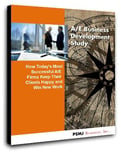Have you ever tried to put together a list of all the parts and pieces of an outstanding, workable business development program? Here’s our list to get your architecture or engineering firm started:
-
Strategic plan and overall BD strategy. Include an analysis of markets and definition of quality and strategic clients.
-
Marketing and sales plans. These are essential at several levels—company, branch, department, individual. Use these plans to set and monitor progress toward goals.
-
BD budgeting and staffing. Know who is assigned to what duty and how much the whole BD effort will cost.
-
Collateral materials. Brochures, website, printed materials to support the program.
-
Conferences and trade shows. Conferences enable you to showcase technical talent; trade shows let you exhibit your wares. Include exhibit materials (banners, etc.) and give-aways.
-
Training and mentoring program. Available to people at all levels.
-
An effective go-no go process. Remember, you’d rather win 2 of 3 than 4 of 10.
-
Over-the-top winning proposals and presentations. Don’t forget, the client sees how you handle proposals and presentations as a reflection of how you will handle the job!
-
Client relationship management. On average, 75 percent of a firm’s work comes from 25 percent of the clients—existing clients! Include client management in your BD program.
-
Effective debriefings. Without debriefing, you never really know why you lose… or win! So you continue making the same mistakes over and over, perhaps expecting a different result—one definition of insanity!
-
BD benchmarking. Attend BD training programs available from PSMJ and others. Complete the PSMJ quarterly survey—you then get to see how you benchmark against many others across the country.
What pieces are you missing? What pieces are your weakest? Make a “to-do” action item as one of your three take-aways from this issue.

In PSMJ's complimentary report, A/E Business Development Study: How Today’s Most Successful A/E Firms Keep Their Clients Happy and Win New Work, we asked a range of questions relating to firms’ business development efforts, including: If firms have a full-time business development staff and how it functions, and how they train their full-time business development staff. Then we overlaid that data against firms’ financial performance, proposal performance, and client satisfaction, i.e. their business development effectiveness.
You also might be interested in these related posts:
10 Good Business Practices for Firm Success
Are You Asking the Right Questions in Planning Your Firm's Strategy?




